Art & Exhibitions
David Ebony’s Top 10 New York Gallery Shows for February
These are the best contemporary art exhibitions currently on view in New York City.
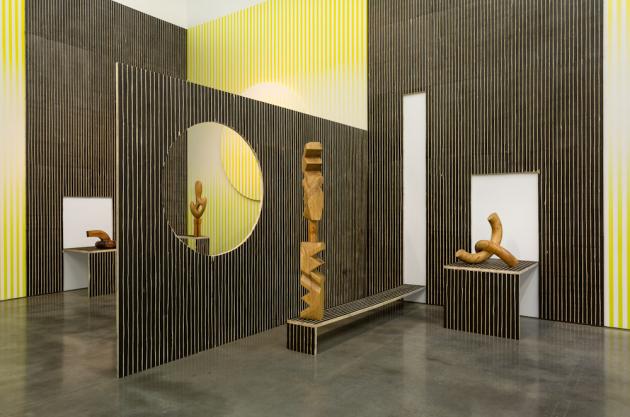
These are the best contemporary art exhibitions currently on view in New York City.

David Ebony

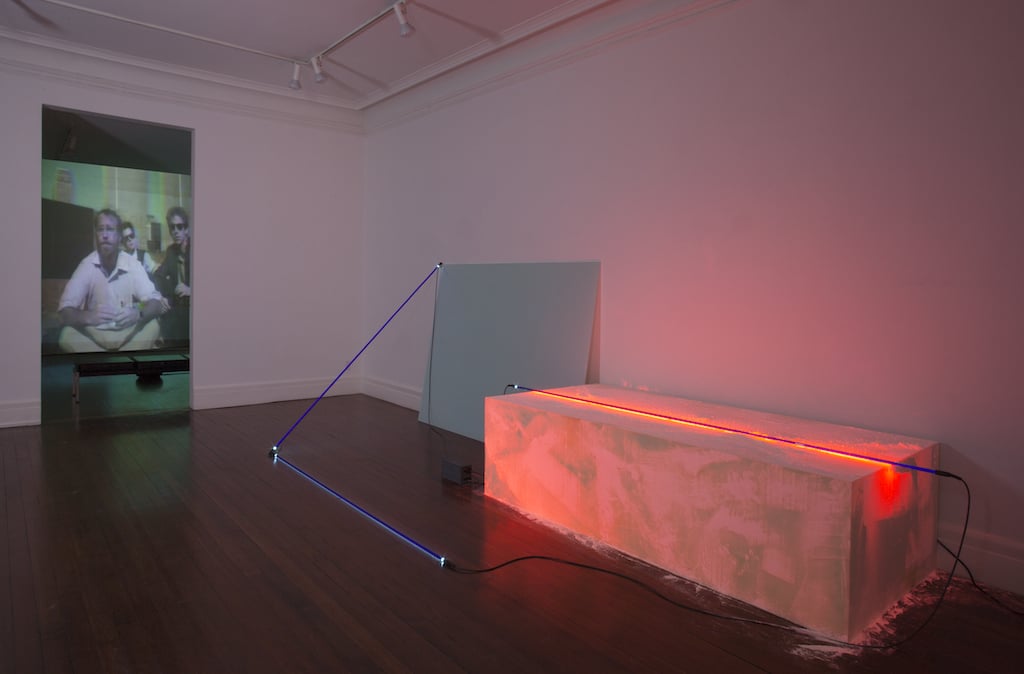
Keith Sonnier, “Castelli Warehouse 1970/Castelli Gallery 2015,” installation view.
Photo: Courtesy Castelli Gallery.
1. Keith Sonnier at Castelli Gallery, through March 28
A lot of art being made these days recalls work Keith Sonnier produced decades ago. Prescient yet still underappreciated, Sonnier in the late 1960s was a pioneer in the use of found materials and ephemeral installations in his experimental works. He incorporated neon, ultraviolet light, and phosphorescent pigments in complex sculptural arrangements that engage the body, offering viewers a total immersive experience in art—one of the first artists to do so. Exploring Minimalism while exploding its conventions, Sonnier also experimented with the fourth dimension by means of video installation in its nascent phase as an artist’s medium.
For this compact but potent exhibition, containing just three major works—two installations and one video projection—the Louisiana-born New York artist has revisited and revised some of his earlier strategies, processes, and motifs. The venue is resonant, too. “Castelli Warehouse 1970/Castelli Gallery 2015,” the show’s title, alludes to Sonnier’s first New York solo exhibition, at the Castelli Warehouse in 1970. The works he showed there, such as Ba-O-Ba Florescent and Ju-Ju, environments infused with ultraviolet light, are not exactly duplicated in the current exhibition. In any case, a recreation of the 1970 show would have been impossible in the limited space here (only seven people are permitted in the gallery at one time). Nevertheless, the ideas come across just as well 45 years later. Sonnier has remained true to his original vision and conception, and the works today are fresh, exhilarating and unforgettable.
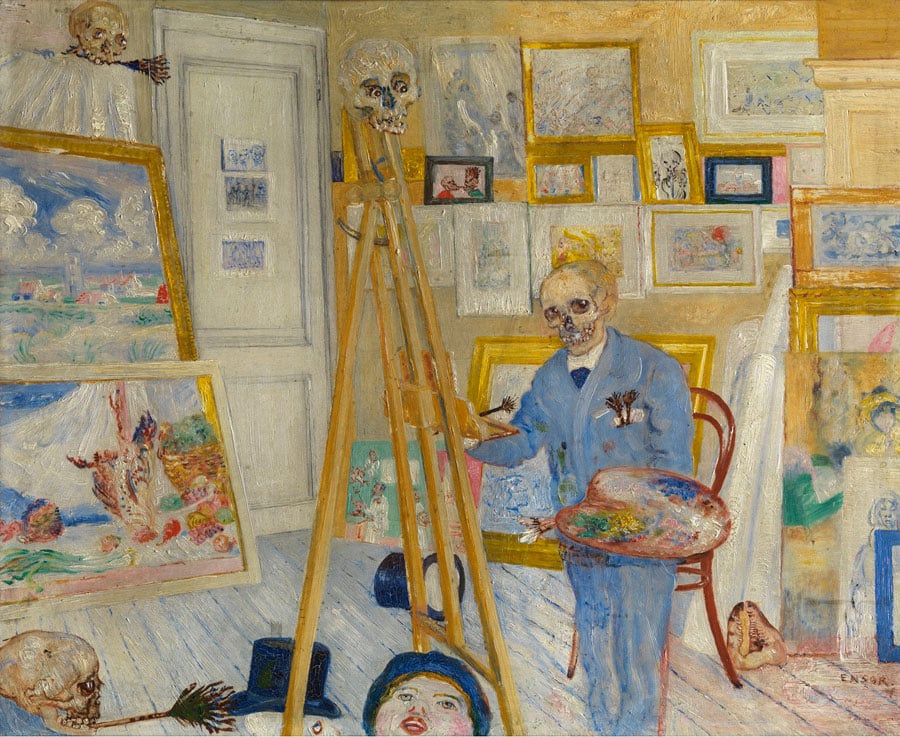
James Ensor, Squelette peintre (The Skeleton Painter) (ca. 1896), Koninklijk Museum voor Schone Kunsten, Antwerp.
Photo: Courtesy Gagosian Gallery © 2014 Artists Rights Society (ARS), New York/SABAM, Brussels.
2. “In the Studio,” at Gagosian, through April 18
In this massive, two-part exhibition, the concept of the artist studio as a locus for private contemplation and public exposure is explored in great detail and depth. Organized by MoMA chief curator emeritus John Elderfield, “In the Studio: Paintings,” at 522 West 21st Street, constitutes a museum-quality survey of some 50 works, arranged more or less chronologically. A vast time span and a stellar array of artists are represented, from William Hogarth to Jasper Johns. Among the many highlights: Jean-Léon Gérôme’s 1890 neoclassical gem, Working in Marble or The Artist Sculpting Tanagra, shows a nude model seated next to her stone doppelgänger. The scene looks quite contemporary, like a snap taken in John DeAndrea’s studio. Similarly arresting, James Ensor’s iconic The Skeleton Painter (ca. 1896) offers a rather macabre view of artistic pursuit.
Part Two of the exhibition, “In the Studio: Photographs,” curated by Peter Galassi, former chief curator of photography at MoMA, appears on two floors at Gagosian’s 980 Madison Avenue location. Thematically rather than chronologically arranged on two floors, with 150 works by 40 artists, ranging from Thomas Eakins to Robert Mapplethorpe, the show at first appears rather disjointed compared with Part One. But it contains many iconic and some fresh images; and Galassi succeeds in his aim here, which is primarily to show how photography has radically altered the notion of an artist’s studio practice.
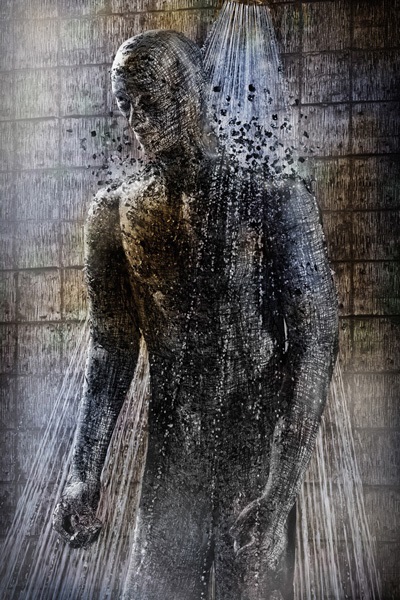
Jasper de Beijer, 4-26-1986, from “Mr. Knight’s World Band Receiver” (2014)
Photo: Courtesy Asya Geisberg.
3. Jasper De Beijer at Asya Geisberg, through March 14
The haunting photographic images by Jasper de Beijer in this show appear from a distance to be large-scale drawings. The black-and-white and sepia-toned pictures of ghostly figures and eerie cityscapes look like richly textured palimpsests. Drawing in fact is central to de Beijer’s elaborate process. In his studio, the 42-year-old Amsterdam-based artist creates intricate tableaux of figures and architectural models in plaster, cardboard and paper. He adds texture and nuance to the sculptural forms by covering them with ink, graphite and charcoal drawing. He then photographs the objects; transposed to flat, slick two-dimensional surfaces, the images are even more uncanny, often nightmarish and hallucinatory.
De Beijer works in series, each image connected by a strong narrative thread. This show, “Mr. Knight’s World Band Receiver,” centers on the true story of a hermit, Christopher Knight, who disappeared one night into a remote forest in Maine. For 27 years Knight had no contact with the outside world, and received information about events such as the Chernobyl disaster and Hurricane Katrina only through radio reports. De Beijer constructs what he imagines Knight would have envisioned had he attempted to visualize these events by means of only verbal descriptions. It’s an audacious enterprise, and the results are wholly convincing and emotionally wrought.
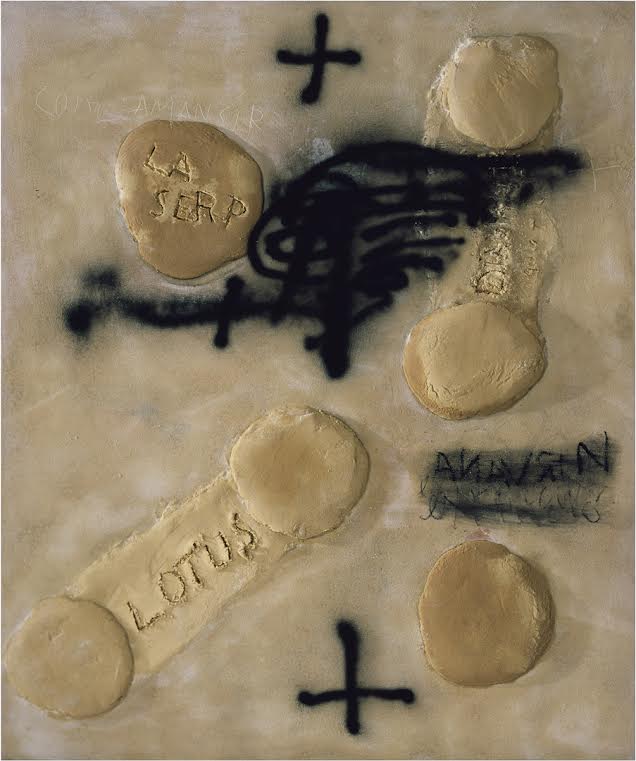
Antoni Tàpies, Lotus (2003–2004).
Photo: Courtesy Pace Gallery.
4. Antoni Tàpies at Pace, through March 21
This is the first posthumous New York exhibition of works by the Spanish artist Antoni Tàpies (1923–2012), renowned for his hybrid paintings–sculptural objects incorporating unorthodox materials like cement, resin, marble dust and found objects. Somber in tone and consistently elegant in execution, the works are imposing and often heroic in both scale and emotional intensity. The show coincides with a full-scale Tàpies retrospective at the Pérez Art Museum Miami, on view through May 3.
The once Barcelona-based artist conveyed a consistent attitude and world-view in his art for many years, producing works that are alternately figurative, abstract, intimate and universal. The New York show offers a particularly fine selection containing prime works, ranging from early 1960s examples of his “matter painting,” through to some of his last works, among them, Figures (2010), featuring vibrant black lines against a white ground suggesting an embracing couple. Lotus (2003–2004), a classic work, is an expansive painting in sand-colored marble dust and resin, featuring graffiti-like scrawls and etched lettering. The show includes Gran Forma de Materia (1988), one of my favorite Tàpies paintings of the 1980s. This monumental painting shows an abstracted face with red lips and a white bandanna atop its pointed head. Perhaps alluding to a victim of war or strife, it’s an extraordinary tour de force, both physically imposing and intellectually stimulating.
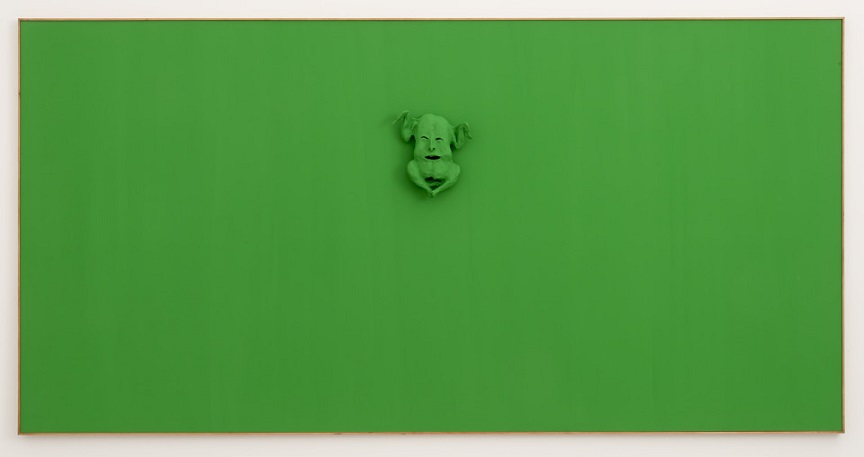
Calvin Marcus, Green Calvin (2014).
Photo: Courtesy Clearing.
5. Calvin Marcus at Clearing, through March 15
For this exhibition “Green Calvin,” Calvin Marcus, a young, Los Angeles–based artist of promise, filled this spacious Bushwick gallery with 10 recent monochrome green paintings, uniform in size (about 48 by 96 inches), with a teeth-gnashing shade of green-painted surfaces, and a ceramic plucked chicken attached near the center of each canvas. The only relief to this insistent image is a fake door installed in a rear gallery. Is this show a jokey pun on Minimalist painting, the entire enterprise of art-making, or an exercise in sober introspection? It’s hard to tell, and the head-jamming ambiguity of the work seems to be the point.
Marking his New York solo debut with this riveting show, Marcus challenges viewers to find some sort of stable ground with which to make sense of his seemingly crazy endeavor. On close inspection, each of the chickens sports humanoid features—eyes, nose and a mouth—on its breast, which ostensibly constitute a self-portrait. It is true that each work suggests a different mood—a smile, a frown, laughing or thoughtful introspection, if that’s not going too far. In any case, this is a provocative show that won’t be forgotten any time soon.
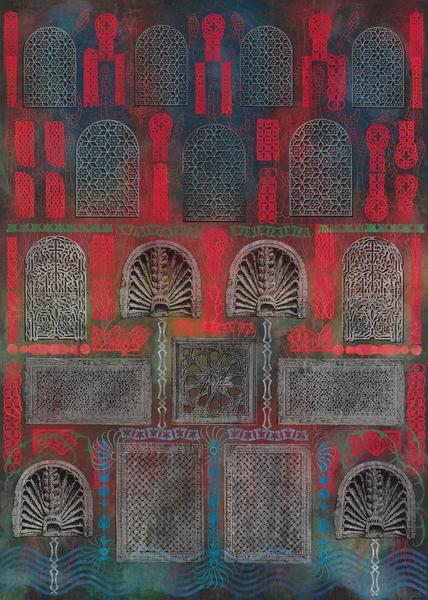
Philip Taaffe, Imaginary Fountain (2014)
Photo: Courtesy Luhring Augustine.
6. Philip Taaffe at Luhring Augustine Bushwick, through April 26
If you have made the trek to Brooklyn’s Bushwick district to see the Calvin Marcus show at Clearing, don’t miss this wonderful exhibition of new paintings by Philip Taaffe on view around the corner. There are five, mural-size abstract canvases on display, each a mesmerizing composition featuring Taaffe’s signature arrangements of repeated geometric shapes, organic forms, and ornamental patterns often borrowed from Islamic art and ancient Greco-Roman architecture.
Spiral Painting II (2015) shows layers of large, overlapping translucent spirals in subtle shades of yellow, orange, blue and black. A sense of rhythmic movement ensues as the circular forms vie for predominance. Imaginary Fountain (2014) is another resplendent work, with vertical rows of architectural details, such as window lattice and ornate doorways, and strands of chain-like forms suggestive of running water. This evocative painting suggests a confluence of vast expanses of time and space, from antiquity to the present moment. In this show, the New York artist breaks no new ground, but the monumental paintings here mark a new high point in Taaffe’s career.
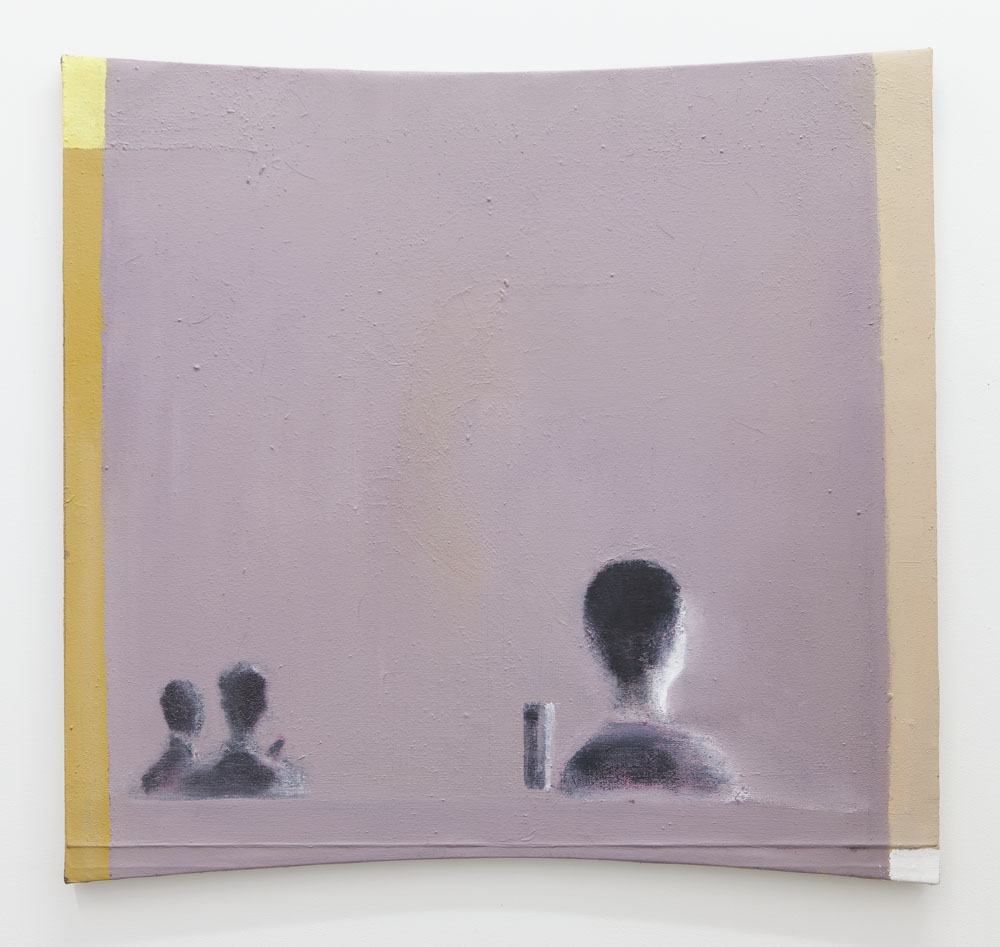
Merlin James, Untitled (2010–2015).
Photo: Courtesy Sikkema Jenkins & Co.
7. Merlin James at Sikkema Jenkins & Co., through March 7
No two paintings by Merlin James look alike, and that is a large part of their strength and appeal. In this densely packed show, “Genre Paintings,” the Welsh-born artist cavalierly explores a wide range of abstract and figurative motifs, seemingly unconcerned with establishing any sort of formulaic continuity. His only concession to a format seems to be in terms of scale, which remains relatively modest, as his works never extend over a couple of feet in either dimension.
Bridge (2014), is a relatively detailed painting of a suspension bridge seen from a treeless hillside above the muddy river bank. The work’s richly textured surface conveys a palpable sense of the materials—earth and metal—highlighted in the image. In a number of works James uses a surface with concave sides, suggesting a topological twist on painting’s conventional rectangular format. Outstanding among these is an untitled work (2010–2015) that shows the backs of three human heads facing an infinite sky painted a delicate shade of pale mauve. Bands of yellow and ochre secure the right and left sides of the composition. This work and numerous others in the show demonstrate James’s technical prowess—the consummate brushwork and extraordinary color sense—not to mention the seemingly inexhaustible range of imagery, that makes his work unique.

Claudia Comte, No Melon No Lemon (2015), installation view.
Photo: Courtesy Gladstone Gallery.
8. Claudia Comte at Gladstone, through March 21
In this, her striking New York debut, Swiss-born, Berlin-based artist Claudia Comte presents what appears to be a single site-specific installation, No Melon No Lemon, filling the large gallery. With walls painted in narrow black-and-white, or yellow-and-white vertical stripes—one with a large circular hole—the installation features a variety of plinths, some at eye level and others far above or below. Placed on the plinths are abstract wood sculptures. The installation as a whole resembles an exhibition of modernist sculptures, by Brancusi or Arp, perhaps. The sculptures are, in fact, Comte’s saw-cut wood sculptures in walnut and mahogany.
The exhibition’s palindrome title is a clue to Comte’s endeavor. Sculpture naturally engages its surrounding space, and the artist manipulates that relationship by creating an environment that is inextricable and integral to the objects. In this case, a tension arises as Comte’s abstract, organic sculptural forms confront the rigid geometry of the stripped walls. In her work, Comte reexamines some fundamental notions about objects in space and how they are perceived, especially by those who navigate the installation. In a rather quirky and humorous way, No Melon No Lemon offers a very engaging puzzle.
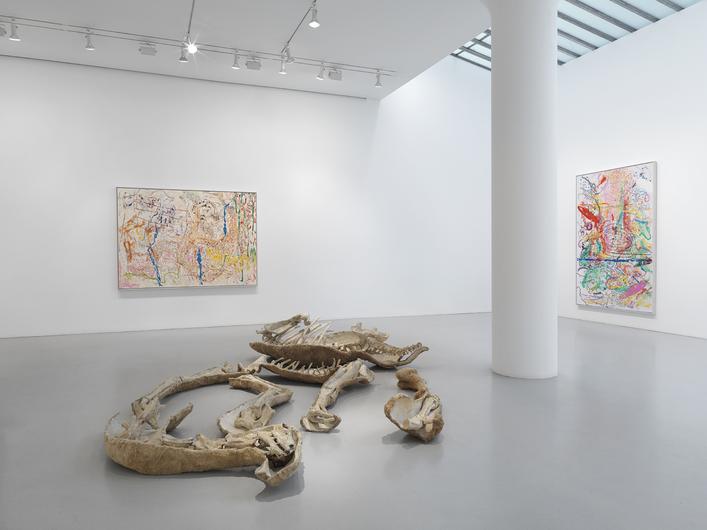
Nancy Graves, installation view, 2015.
Photo: Courtesy Mitchell-Innes and Nash.
9. Nancy Graves at Mitchell-Innes & Nash, through March 7
Nancy Graves (1939–1995), was a key figure in the transition from the dominant forms of Minimalism and Conceptualism that marked the late 1960s and ’70s, toward a more pluralistic view of art production that became widely embraced in the 1980s and later. This show features a number of strong and rarely exhibited examples from the artist’s estate. The image of a camel was central to her work of the 1970s, as part her vocabulary of “realistic illusions” and “natural fictions.” Her cryptic camel skeleton sculpture, Inside-Out (1970), made of steel, wax, marble dust, fiberglass, and animal skin, is a highlight of the show. Also on view, projected high on one wall, are a series or early videos, including Izy Boukir (1970), a film shot in the Sahara, featuring music by Philip Glass. Equally remarkable are her colorful, large-scale paintings from the “Camouflage” series of the 1970s; they prove that Graves was far ahead of her time.
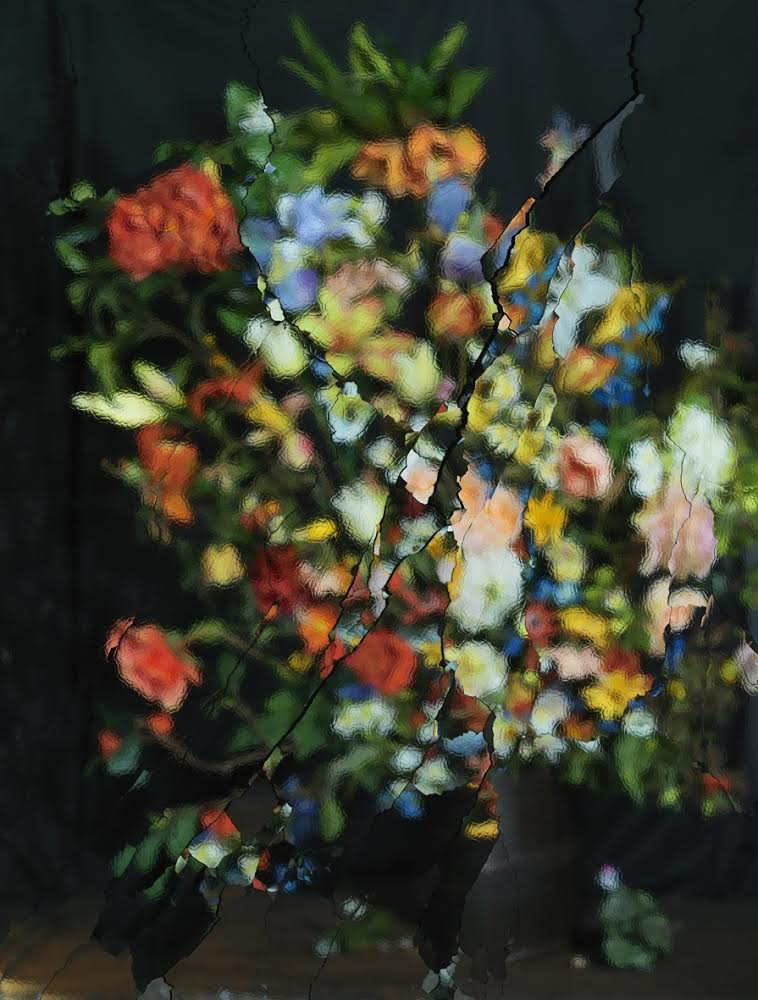
Ori Gersht, “On Reflection, Material: After J. Brueghel the Elder E06” (2014).
Photo: Courtesy CRG.
10. Ori Gersht at CRG, through March 14
In this show of recent large photos and a new video installation, “On Reflection,” Ori Gersht uses shattered flowers and broken glass as metaphors in his latest exploration of the cycle of creation and destruction. His process is fascinating, like something photographer-inventor Harold Edgerton might have dreamed up. Related to his previous series of exploding frozen flowers, Gersht’s new images were inspired by Jan Brueghel the Elder’s floral paintings from 1606. The Israeli-born, London-based artist recreated the flowers in silk. The still lifes were then placed before tempered glass mirrors outfitted with electrified wires. As an electric charge shatters the broken glass, multiple cameras aimed at the mirrors capture the exploding facets, each with a fractured image of the still life. Much of the process is visible in a hypnotic, multi-screen video on view in the rear gallery. The resulting kaleidoscopic photographic images are often gorgeous and breathtaking, like shattered dreams made visible.
David Ebony is contributing editor for Art in America and a longtime contributor to artnet.